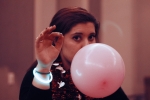In early July I had the pleasure of visiting the studio of artist Nicholas Kahn. Though he has his primary studio in Hudson, Nicholas also works in his farmhouse where he has cultivated a menagerie of objects from Mexican devil figures to dead bats and taxidermies. As I am studying photography, it was a rare opportunity to see his artistic process, although for the majority of my visit Nicholas was working on a watercolor painting, another one of his mediums. Some of his other works are heavily inspired by 17th century dutch art and pagan religions ( especially the Greenman), which are prevalent in his floor to ceiling tapestries. After finishing up with his painting, which ended up being a pangolin suspended over valley and Hudson River, we headed out to a local waterfall to work on “Dreams of the Drowning World,” a portrait series by Nicholas and fellow artist Richard Selesnick. I must say that being dressed up like a disheveled circus performer (some of Nicholas’ other inspirations are avant garde ballet and circus/Mardi Gras parades) and partially submerged in a creek was not part of my plan, but it yielded some amazing portraits, and it gave me some insight into his photographic process.
Nicholas and Richard’s works can be seen by visiting kahnselesnick.biz.





































Recent Comments